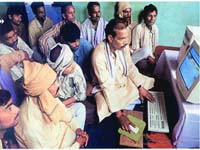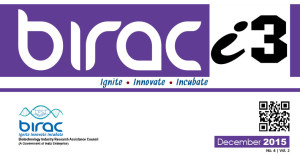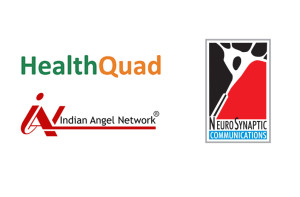 Could information and communication technology (ICT) be that great leveller that has eluded society from the beginnings of modern civilisation?
Could information and communication technology (ICT) be that great leveller that has eluded society from the beginnings of modern civilisation?
At a macro level, it’s pretty well-known how ICT has impacted and transformed every field from agriculture and medicine to meteorology and aeronautics. But in the context of ICT for development and bridging the digital divide, what is really of concern is to extend the benefits of technology to people who have traditionally been left out of the game. When we talk of the technology ‘have-nots,’ our goal is not necessarily to get them all to use and buy computers or mobile phones. Yet there are innumerable specific areas in which ICT can be used to improve the lives of this underprivileged lot and provide them with opportunities that would otherwise be unlikely to come their way. Information technology is also enabling microfinance systems, which in turn encourage microenterprise, stemming the endless and unsustainable rural-to-urban migration that’s the bane of the developing world. Here are but a few examples of how ICT is improving the life of rural populations in India, which as a country has been witness to the entire range of problems as well as potential solutions associated with the digital divide.
Telemedicine: Tens of thousands of villages in the rural areas of the poorer countries remain without adequate healthcare facilities. Even as primary healthcare centres and makeshift dispensaries are being constructed, there is a perennial shortage of trained doctors and nurses. For instance, India has just one doctor for every 15,000 people, and specialists are even rarer. Almost 70 percent of India’s population is rural, while over 80 percent of doctors live in cities. But, with videoconferencing and remote diagnostic kits, thousands of villagers are now inexpensively enjoying the same level of treatment as their urban counterparts. One company, Neurosynaptic Communications, has developed inexpensive telemedicine kits with facilities for checking blood pressure, body temperature and ECG. The kit is also equipped with an electronic stethoscope, and soon will have other physiological and biochemical tests integrated. The diagnostic kit is connected to a kiosk with videoconferencing facilities, and readings are transmitted over low bandwidth links, permitting interaction between the doctor and remotely located patient, and hopefully, more accurate diagnosis. Apart from the obvious extension of quality healthcare to areas that couldn’t before afford it, this system could bring down the cost of rural healthcare in India by a third.
Transparent governance: Interactions between the citizenry and government or bureaucracy can often be frustrating, and this is particularly so in the developing countries where disorder and corruption are relatively more pronounced. Information technology could take transparency and accountability of government to new levels because of the increased efficiencies and controls made possible, and decreased scope for manipulation by corrupt officials. But it is in responsiveness to the immediate needs of citizens that the impact can be directly felt. One striking example is the computerisation of land records in Karnataka. Under the ‘Bhoomi’ project, the state government set out in 1999 to computerise some 20 million land deeds, and ownership and tenancy certificates, covering 30,000 villages and nearly seven million farmers. The service was launched in 2002, and since then land-owning small farmers and others have been able to check and obtain printouts of their computerised land records (required for various transactions) quickly and inexpensively. Prior to this, they were at the mercy of the village sarpanch (headman or accountant) who invariably made things difficult and extracted varying sums of money for the ‘favour’ of providing them information that’s rightfully theirs. With the new system, it’s estimated that the farmers collectively save Rs 90 crore ($20 million) per year in terms of bribes they would otherwise have had to pay. Meanwhile, Bhoomi earns Rs 12 crore ($2.6 million) a year from the reasonable fees charged to the farmers for queries and printouts, as well as from additional sums from charges to companies that wish to mine the mammoth database for commercial information.
 Elimination of the middleman: A perennial problem for rural producers of food grains, dairy products and other goods is finding a fair price for their produce. They’re often at the mercy of middlemen who short-change them mercilessly. During the early dotcom boom, a widely held view was that small entrepreneurs and craftsmen would benefit from the Web because they would now have a worldwide customer base through e-commerce and online shopping. This view proved to be rather far-fetched, but as e-commerce matures, smart companies in rural India are using kiosk-based computers to deal directly with farmers to procure oilseeds and other raw material for the processed foodstuff and other consumer products they manufacture. In this regard, diversified private sector conglomerate ITC Limited has been hugely successful with its ‘e-Choupal’ initiative. This digital alternative has replaced the traditional physical ‘mandi’ marketplace for farmers. These farmers now check prices on the e-Choupal information kiosks and sell their soybean, coffee, wheat, rice, pulses, etc. directly to the company (ITC). By eliminating the middleman, not only do the farmers get a fairer deal, but ITC has reported that it too saves close to 10 percent on its purchases. e-Choupal now covers 31,000 villages through over 5,000 kiosks accessible to 3.1 million farmers across six Indian states. The number of villages in India was 638,365 at last count.
Elimination of the middleman: A perennial problem for rural producers of food grains, dairy products and other goods is finding a fair price for their produce. They’re often at the mercy of middlemen who short-change them mercilessly. During the early dotcom boom, a widely held view was that small entrepreneurs and craftsmen would benefit from the Web because they would now have a worldwide customer base through e-commerce and online shopping. This view proved to be rather far-fetched, but as e-commerce matures, smart companies in rural India are using kiosk-based computers to deal directly with farmers to procure oilseeds and other raw material for the processed foodstuff and other consumer products they manufacture. In this regard, diversified private sector conglomerate ITC Limited has been hugely successful with its ‘e-Choupal’ initiative. This digital alternative has replaced the traditional physical ‘mandi’ marketplace for farmers. These farmers now check prices on the e-Choupal information kiosks and sell their soybean, coffee, wheat, rice, pulses, etc. directly to the company (ITC). By eliminating the middleman, not only do the farmers get a fairer deal, but ITC has reported that it too saves close to 10 percent on its purchases. e-Choupal now covers 31,000 villages through over 5,000 kiosks accessible to 3.1 million farmers across six Indian states. The number of villages in India was 638,365 at last count.
Information revolution: Information kiosks are evolving as the preferred means of getting relevant information and knowledge to the technology have-nots without them having to learn how to use complicated, language-specific interfaces. The kiosks consist of one or more computers (sometimes with touch-screen interfaces) that are connected to the Internet via a combination of wired and wireless links, including phone lines, VSATs and Wi-Fi. The kiosk provides information about weather conditions, fertilisers, crops, healthcare and other village issues. In some cases, like the e-Choupal, it also serves as an e-commerce hub where the farmers order seed, fertiliser and other consumer products from ITC and its partners. The kiosk model is rapidly proliferating throughout semi-urban and rural India, and there are about 10,000 kiosks deployed, each serving five or six surrounding villages.
Are all these just exceptional examples, or are they an indication that technology has reached a level that can make it truly ‘enabling’ for all of mankind? That’s a discussion for the concluding part of this series, two weeks from now.
Val Souza, Consulting Editor
valsouza@expresscomputeronline.com
Source: Express Computer




